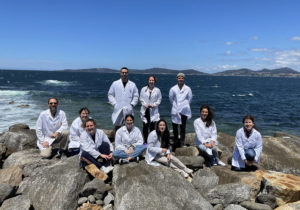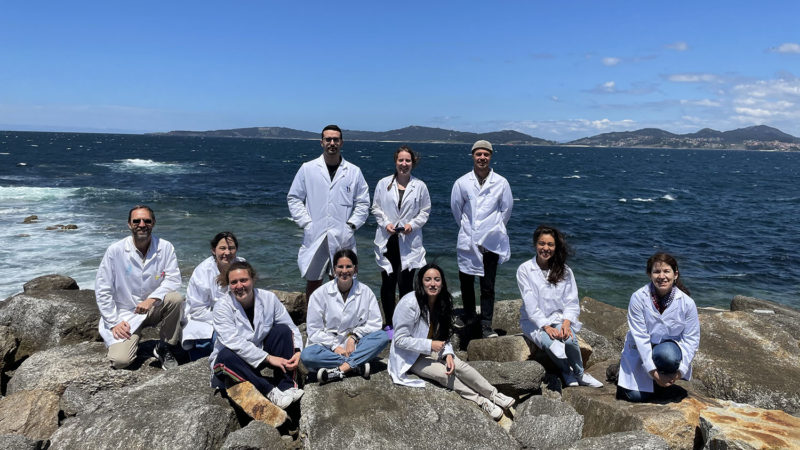In the last years many different research projects focused on confirming plastics´s and microplastis´s presence and their impact on the marine environment have been developed. However, 80% of these particles that are in the Earth´s seas and oceans have a mainland´s origin. Therefore, to get a better understanding of this problem, it is key to carry out a wide and multidisciplinary approach like the one that the research project LabPlas, funded by the H2020 and coordinated by the University of Vigo, is going to follow.
The initiative, funded with 5 Millions of euros (half Million allocated to the UVigo), is made up of 16 research partners belonging to eight countries who have as their main goal to track the mains plastics´s sources in the environment. To achieve this, the project gathers experts in pollution assessment, environmental modelling, environmental chemistry, oceanography, hydrology, paleoecology, soils ecology, microbiology, water engineering, nanotechnology, economy and knowledge transfer. In the project participate the following research groups from the University of Vigo: the Ecotox group, led by Ricardo Beiras; the Animal Ecology group, led by Jorge Domínguez; and the group of Dolores Garza, Erenea (Economy of Natural Resources and Environment).
The PI of the LabPlas Project (Land-Based solutions for PLAStics in the sea) is Professor Ricardo Beiras who explains that the “main goal is to reduce the entry of plastics in the environment”. The groups will work together to study the interactions of plastics with the environment and the natural cycles; determining their origin, typology, and the waste size and their route until arriving to the marine environment. With this knowledge, the researchers aim to provide the public administrations and businesses with tools that allow them to fight plastic pollution based on solid scientific bases. To carry out this, they will have practical computational tools to create a map of the key points affected by the plastic.
One of the research lines of the project will be the microplastics. They cannot be eliminated by nature, and, therefore, focus the scientific community efforts on trying to avoid their release to the environment from the degradation of containers, bottles, clothes, etc. As it has been highlighted by the UVigo´s Professor, despite that there are an increasing number of studies carried out about microplastics, “still there is a lack of analytical methods suitable and validated for detecting and quantifying the micro and nanoplastics, implying that their monitoring within this project will be a great challenge”.
Field work in two main sites
The work, which will start this June, will focus on sampling during the first two years of the project and the environmental modelling in the following two. The consortia will study terrestrial and aquatic areas, being in the latter case both marine and freshwater. To do so, two main geographical sites have been determined. On the one hand, the North Sea and the Thames and Elbe rivers that flow into that sea, “being a wide geographical area that will be an example on how plastics come from the mainland through rivers that flow into the sea”. On the other hand, samples will be also taken in a small area of Galicia, in the Cecebre reservoir, that provides of drinking water to the city of A Coruña. The consortia will analyze the potential effect of the presence of microplastcis and chemical additives in the drinking water by studying the Barcés and Mero rivers, the reservoirs and the continuation of the Mero river until its mouth in the Burgo. Another study site will be around the AP9 motorway, as it is an area that receives microplastics coming out from car tires through the friction with the asphalt.
Sampling
To track the plastic sources, the work teams will take samples of water, sediments, soils and even organisms that are able to ingest microplastics. However, regarding the latter, Beiras points out that the main way of exposure for human beings to plastic are not the marine organisms, “it is very far-fetched to think that fishes are the main way of exposure, as microplastics can be found in dust, drinking water, clothes fibers, everywhere”.
The researchers will monitor the presence of macroplastics (> 25mm), mesoplastics (5-25mm), large microplastics (1-5mm) and small microplastics (1µm – 1mm). The large differences in size of the samples is one of the difficulties of the work, as sampling equipment will require to use different tools and gadgets to capture each of the sizes.
After the first two years of field work, the collected data will feed environmental models that will try to follow the movement of each size fraction in the environment “to find out where they are more abundant, whether they remain in the water column or sink to the bottom, or if they are ingested by organisms, etc”.
Finally, the last work packages will consist in offering the knowledge and tools generated to the public administrations and regulatory agencies to improve the directives and legislation that is continuous development.
The chemical additives of biodegradable plastics
One of the innovative topics of this project is that the chemical additives that are used in manufacturing the biodegradable plastics will be also studied, a very worrying topic not very often addressed, according to the researchers. As Ricardo Beira says, the main problem of a plastic object is not the polymer of which is made, but the chemical additives that are used to be able to work with them, that gives them color, that provides them of heat or light resistance etc…which in many cases are toxic”. In the manufacturing of biodegradable plastics, “that mineralize and disappear”, a higher amount of these type of chemical substances are used. “To manufacture plastic from potato starch or sugar cane, a higher amount of additives is required in order to have marketable properties. In other words, you create a plastic that is degradable, but you have to pay attention which additives and how many of them you use”.
Therefore, one of the work packages of LabPlas will focus on analyzing the presence of these additives in the nature, evaluate their toxicity and to provide the industry with the ecotoxicological information required to manufacture products as much environmentally friendly as possible within the context of the circular economy. To carry out this, they have BASF as project partner, one of the main companies in the plastic manufacturing industry. They will collaborate in identifying the most toxic additives and search the more suitable ones to manufacture a product able to provide with its function at the same time of being environmentally friendly and complying with the manufacturing and quality control legislation.

Source: DUVI

